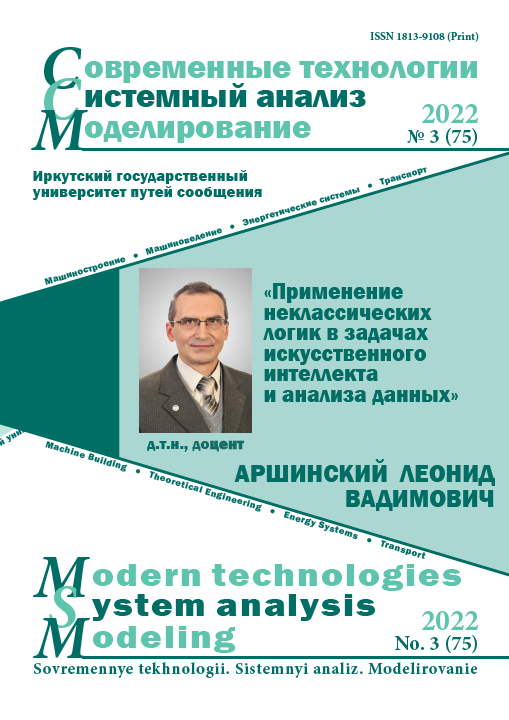Modeling of the compressed air consumption in the pneumatic systems on the example of the train brakes operation during charging and release mode
Keywords:
rolling stock of railways, pneumatic brakes of rolling stock, rolling stock braking system, stationary pneumatic processes, non-stationary pneumatic systems, digital twin of the trainAbstract
The article considers the issue of modeling the pneumatic processes and the universality of pneumatic systems in relation to various sectors of the economy. The simulation is carried out illustrated with the example of the pneumatic braking system of domestic freight rolling stock, for which the scheme of the train's braking equipment with the main braking devices is considered and the directions of air movement through the ducts in the main modes are analyzed. When creating the model, an approach was used with the approximation of experimental data by choosing a mathematical function and selecting its parameters. The simulation was aimed at solving a particular problem of determining the change in the flow of compressed air in the braking system of rolling stock by the pressure in the source (in the main tank) for two modes of operation: charging the toruses and maintaining the charging pressure in the brake line during train mode. The pneumatic system of the train can operate in the consumption mode to saturate the brake devices with compressed air, which implies a non-stationary character of the process. At the same time, the braking system can operate in the mode of compensation for compressed air leaks due to loose joints, implying the stationary nature of the process. Due to these features of the operation of the pneumatic system, two equations were proposed for stationary and non-stationary modes. The proposed solution for modeling the flow of compressed air to reduce the pressure in the source, aside from railway rolling stock, is applicable for similar pneumatic systems of general industrial use.
References
Исследование температуры тормозных колодок с разной степенью износа в процессе фрикционного торможения / П.Ю. Иванов, А.М. Худоногов, Е.Ю. Дульский и др. // Вестн. Урал. гос. ун-та путей сообщ. 2020. № 3 (47). С. 27–34.
Study of the influence of the brake shoe temperature and wheel tread on braking effectiveness / P. Ivanov, A. Khudonogov, E. Dulskiy et al. // Journal of Physics: Conference Series. 2020. P. 012086. DOI 10.1088/1742-6596/1614/1/012086.
Abbasia S., Teimourimaneshb Sh., Vernerssonb T. Temperature and thermoelastic instability at tread braking using cast iron friction material // Wear. 2013. Vol. 314. Р. 171–180.
A. Hamdaoui, El.H. Jaddi. Effects of the brake shoe friction material on the railway wheel damage // MATEC Web of Conferences. 2018. Vol. 149. Р. 1–4.
Petersson M. Two-dimensional finite element simulation of the thermal problem at railway block braking // Mechanical Engineering Science. 2015. Vol. 216. Р. 259–273.
Применение аддитивных технологий при проектировании и изготовлении автотормозного оборудования / Н.С. Горбунова, Е.Ю. Дульский, П.Ю. Иванов и др. // Молодая наука Сибири. 2021. № 1 (11). С. 44–50. URL https://mnv.irgups.ru/en/node/754 (дата обращения 04.03.2022).
Система диагностики тормозной сети поезда / А.М. Худоногов, Е. Ю. Дульский, П. Ю. Иванов и др. // Локомотив. 2019. № 4 (748). С. 30–31.
Кузнецов Ю.В., Кузнецов М.Ю. Сжатый воздух. Екатеринбург : УрОРАН, 2007. 510 с.
Исследование работы стабилизатора крана машиниста условный № 395 / П. Ю. Иванов, Н. И. Мануилов, Е. Ю. Дульский и др. // Инновационные проекты и технологии машиностроительных производств : материалы второй всерос. науч.-техн. конф. Омск, 2017. С. 62–69.
Особенности построения систем управления с применением технологии «цифровой двойник» на основе микроконтроллеров «Миландр» / Н.О. Дробышев, П.Ю. Иванов, С.В. Ковыршин и др. // Молодая наука Сибири : электрон. журн. 2020. № 2 (8). С. 264–269.
Карвацкий Б.Л. Общая теория автотормозов. М. : Трансжелдориздат, 1947. 299 с.
Об утверждении правил тяговых расчетов для поездной работы : распоряжение ОАО «РЖД» 867р от 12.05.2016 : в ред. 02.02.2018. М. : ОАО «РЖД», 2016. 515 с.
Иванов П.Ю., Корсун А.А., Емельянов Д.О. Существующие способы управления тормозным нажатием с повышенной эффективностью // Научные междисциплинарные исследования : сб. ст. XV Междунар. науч.-практ. конф. Саратов, 2021. С. 28–36.
Пудовиков О.Е., Муров С.А. Совершенствование системы автоматического управления пневматическим тормозом грузового длинносоставного поезда // Транспорт: наука, техника, управление. 2014. № 4. С. 21–26.
Иванов П.Ю., Мануилов Н.И., Дульский Е.Ю. Причины самопроизвольного срабатывания автотормозов в грузовых поездах // Известия Транссиба. 2017. № 2(30). С. 17–25.
Зарубежный опыт повышения эффективности пневматических тормозов / П.Ю. Иванов, Е.Ю. Дульский, Н.И. Мануилов и др. // Локомотив. 2020. № 11(767). С. 36–37.
Сравнительный анализ тормозных систем подвижного состава с однотрубным и двухтрубным питанием / П.Ю. Иванов, Е.Ю. Дульский, А.А. Хамнаева и др. // Вестн. Ростов. гос. ун-та путей сообщ. 2020. № 3 (79). С. 35–42.
Мануилов Н.И. Совершенствование методов и средств диагностики тормозной сети поезда : дис. … канд. техн. наук. Иркутск, 2019. 190 с.


